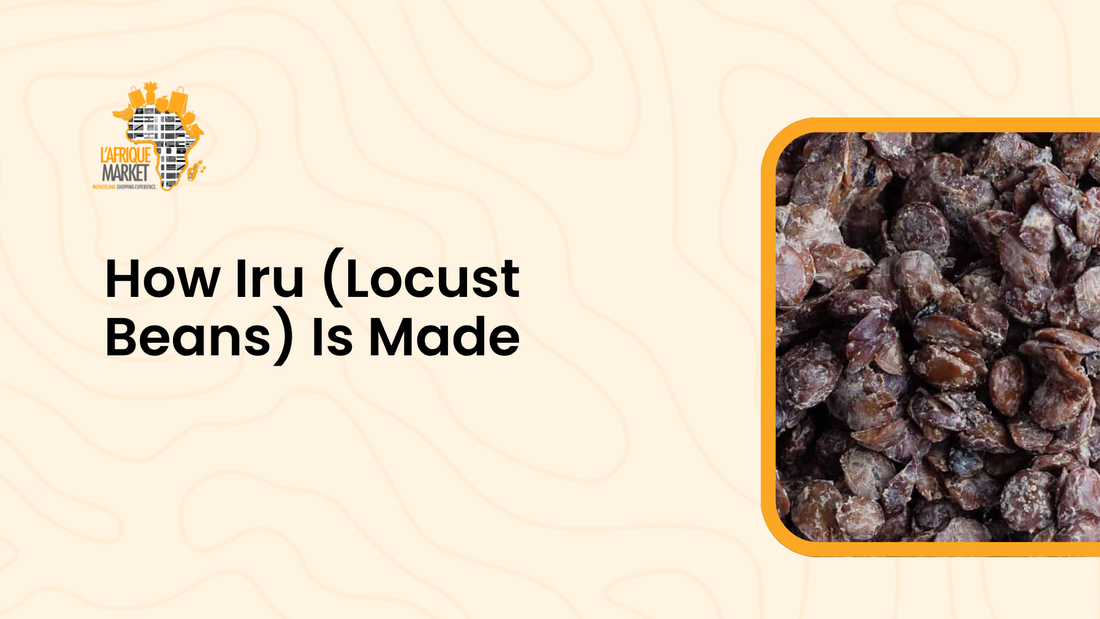
How Iru (Locust Beans) Is Made
Share
If you grew up in a West African kitchen, you know this smell. Sharp. Funky. Deeply savory. Some love it instantly, others take a while — but one thing is certain: Iru (locust beans) transforms soups and stews into something magical.
It’s that umami hit in Egusi, the body in your Ogbono, and the secret depth in many Nigerian, Ghanaian, and Beninese recipes. But do you know how it’s made?
This isn’t just a seasoning. Iru is a labor of love, crafted from nature and time. Let’s take a full walk through the traditional process of making Iru, its health benefits, and how to use it properly in your dishes.
 Image from: Eat well abi
Image from: Eat well abi
What Is Iru (Locust Beans)?
Iru is the fermented seed of the African locust bean tree, Parkia biglobosa, native to West Africa. Known as:
- Iru (Yoruba)
- Dawadawa (Hausa)
- Ogiri Igbere (Igbo)
- Netetou (Senegal/Gambia)
It’s commonly sold as:
- Wet Iru: Soft, packed in leaves or nylons
- Dry Iru: Sun-dried for preservation, shelf-stable
The Traditional Process of Making Iru
Making Iru is an intensive and sacred process, mostly done by women in rural communities. It takes days — and a whole lot of patience. Here's how it’s done:
1. Harvesting the Pods
The locust bean tree produces large, brown seed pods. Inside are:
- Seeds (what we ferment)
- Pulp (naturally sweet and used for snacks or drinks)
After harvesting, the pods are split open, and the seeds are collected and washed.
2. Boiling (for Hours)
The washed seeds are boiled in water — not for 30 minutes, not for an hour — but often 12 to 24 hours until the hard outer seed coats begin to soften and break apart. This softening is crucial to allow fermentation.
Traditional method: over firewood or charcoal pots, large metal drums, stirred continuously.
3. Dehulling (Removing Seed Coat)
After boiling, the seeds are drained and pounded in a mortar or rubbed between palms to remove the tough black seed coat. This reveals the light-brown or yellowish inner cotyledon, which is the edible part.
The dehulled seeds are rinsed thoroughly to remove any remaining skin.
4. Fermentation (The Magic Step)
The clean seeds are wrapped in leaves (like banana or local leaves) or placed in baskets and left to ferment at room temperature for 2–3 days.
During this time:
- Natural bacteria (mostly Bacillus species) break down the seeds
- A strong, pungent smell develops
- The texture becomes soft, sticky, and savory
This fermentation is what gives Iru its rich, complex flavor and health properties.
5. (Optional) Salting and Drying
Some producers add salt to increase shelf life. Iru can then be:
- Sold fresh/wet, wrapped in leaves
- Sun-dried into hard pellets for transport or export
At L’Afrique, we carry authentic Iru that’s well-preserved without additives — ready to go into your next stew.
Also Read: Choosing the Right Rice: What to Use for Jollof, Fried Rice, and More
How to Use Iru in Cooking
Iru is bold. You don’t need a lot. It’s added to:
How to cook with it:
- Add early to the oil to release flavor
- Use a little meat stock to melt it down if using dried Iru
- Can be blended with your pepper mix or fried whole
Health Benefits of Iru
Besides flavor, Iru is a nutritional powerhouse:
- Protein-rich
- Loaded with iron and calcium
- Aids digestion thanks to natural fermentation
- May improve gut health through its probiotic bacteria
- Traditionally used to manage hypertension and diabetes
Where to Buy Real Iru in the USA
Finding real, unprocessed Iru outside of West Africa can be tough. That’s why we stock authentic, sun-dried Iru at L’Afrique Market, shipped to your door, so your cooking never misses that hometown flavor.
👉 Shop Iru & other essential seasonings here:
Explore Seasonings & Spices
